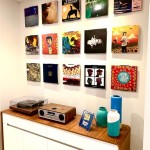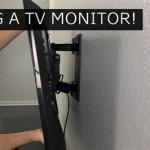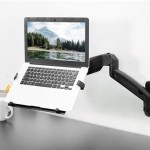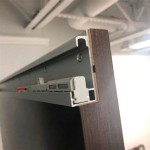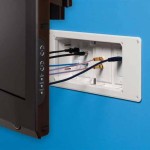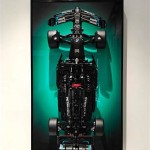LED Monitors with Wall Mounts: Optimizing Space and Enhancing Viewing Experience
LED monitors have become ubiquitous in modern computing environments, offering vibrant displays, energy efficiency, and sleek designs. Pairing these monitors with wall mounts provides a multitude of benefits, particularly concerning space optimization and ergonomic viewing. This article will explore the advantages of using LED monitors with wall mounts, delve into key considerations when selecting both components, and discuss the installation process and potential challenges.
A wall-mounted LED monitor frees up valuable desk space, creating a cleaner and more organized workspace. In smaller offices or home offices, this can be a significant advantage. Instead of a bulky monitor stand occupying a large portion of the desk, the monitor is suspended on the wall, allowing for more room to maneuver and utilize the work surface for other tasks. This can contribute to increased productivity and a less cluttered working environment.
Beyond spatial benefits, wall mounts offer enhanced ergonomic adjustability. Many wall mounts allow for tilting, swiveling, and rotating the monitor, enabling users to customize the viewing angle and position to suit their individual needs. This customization is crucial for maintaining proper posture and reducing strain on the neck, back, and eyes during extended periods of computer use. Proper ergonomic setup can contribute to improved comfort and reduced risk of musculoskeletal disorders.
The aesthetics of a workspace are also enhanced by wall-mounting LED monitors. The clean, minimalist look of a monitor mounted flush against the wall can contribute to a more modern and professional appearance. Cables can be managed and concealed, further enhancing the visual appeal and creating a more organized and visually pleasing environment. This can be particularly beneficial in client-facing areas or for businesses seeking to project a certain image.
Key Advantages of Using LED Monitors with Wall Mounts
The combination of LED monitors and wall mounts offers numerous advantages, making it a popular choice for both personal and professional settings. These advantages extend beyond mere aesthetics and encompass practicality, ergonomics, and overall user experience.
One significant advantage is the ability to reclaim valuable desk space. Monitor stands can be quite large and cumbersome, especially with larger screen sizes. By mounting the monitor on the wall, the entire footprint of the stand is eliminated, freeing up desk space for other essential items, such as a keyboard, mouse, documents, or other peripherals. This is particularly beneficial in compact workspaces where maximizing usable surface area is critical.
Another key advantage lies in the improved ergonomics offered by wall mounts. Most wall mounts provide a range of adjustability, including tilt, swivel, and rotation. This allows users to fine-tune the monitor's position to achieve the optimal viewing angle and distance. Proper ergonomic positioning can help to reduce eye strain, neck pain, and back pain, promoting greater comfort and productivity during long working hours. The ability to easily adjust the monitor's position also allows for sharing the display with others in the room or accommodating different users with varying ergonomic needs.
Furthermore, wall-mounted LED monitors contribute to a cleaner and more organized aesthetic. By eliminating the monitor stand and concealing cables, the workspace appears less cluttered and more professional. This can be particularly important in client-facing areas or in environments where a clean and organized appearance is valued. Cable management solutions, such as cable sleeves or channels, can further enhance the aesthetic appeal by hiding unsightly wires and creating a more streamlined look.
Enhanced security can also be a consideration. While not the primary reason for choosing a wall mount, it does offer a slightly more secure setup compared to a monitor simply sitting on a desk. A properly installed wall mount makes it more difficult for someone to easily remove the monitor, which can be a deterrent to theft or accidental damage, especially in public spaces or high-traffic areas.
Selecting the Right LED Monitor and Wall Mount
Choosing the appropriate LED monitor and wall mount requires careful consideration of several factors to ensure compatibility, functionality, and optimal performance. Ignoring these factors can lead to installation difficulties, compromised ergonomics, or even damage to the monitor or the wall.
The first step is to determine the appropriate screen size for the intended viewing distance and application. Larger screens are generally better for multimedia consumption and tasks requiring detailed visuals, while smaller screens may be more suitable for basic office work or situations where space is limited. Consider the resolution of the monitor as well. Higher resolutions provide sharper and more detailed images, which can be particularly beneficial for tasks involving graphics, video editing, or detailed data analysis.
The VESA (Video Electronics Standards Association) mounting standard is a crucial factor to consider. VESA specifies the hole pattern on the back of the monitor used for attaching it to a wall mount. Ensure that the monitor and wall mount both support the same VESA standard. Common VESA patterns include 75x75mm, 100x100mm, and 200x200mm. If the monitor's VESA pattern does not match the wall mount, adapters are available, but it is generally preferable to choose components that are directly compatible.
Next, evaluate the weight capacity of the wall mount. The wall mount must be able to safely support the weight of the monitor. Exceeding the weight capacity can lead to the mount failing, potentially damaging the monitor and causing injury. Check the specifications of both the monitor and the wall mount to ensure that the mount's weight capacity is adequate. It is always wise to choose a mount with a weight capacity that exceeds the monitor's weight by a margin of safety.
Consider the type of wall mount needed. There are several types of wall mounts available, including fixed mounts, tilting mounts, swivel mounts, and full-motion mounts. Fixed mounts are the simplest and most affordable option, providing a static viewing angle. Tilting mounts allow for adjusting the vertical angle of the monitor, which can be useful for reducing glare or improving viewing comfort. Swivel mounts allow for rotating the monitor horizontally, which can be useful for sharing the display with others in the room. Full-motion mounts offer the greatest flexibility, allowing for tilting, swiveling, and extending the monitor away from the wall. Choose the type of mount that best suits the intended application and ergonomic needs.
Examine the build quality and materials of the wall mount. A sturdy and well-constructed mount will provide greater stability and durability. Look for mounts made from high-quality steel or aluminum. Check for smooth and reliable mechanisms for adjusting the monitor's position. Read reviews from other users to get an idea of the mount's performance and reliability. A higher-quality mount may cost more, but it will provide greater peace of mind and ensure that the monitor is securely supported.
Installation Process and Potential Challenges
Installing an LED monitor with a wall mount is a relatively straightforward process, but it requires careful planning and execution to ensure a safe and secure installation. Proper tools and attention to detail are essential for avoiding damage to the monitor, the wall, or the user.
Before beginning the installation, gather the necessary tools and materials. This typically includes a drill, screwdriver, level, stud finder, measuring tape, pencil, and safety glasses. A stud finder is essential for locating wall studs, which are the structural members of the wall that provide the necessary support for the monitor and mount. Avoid mounting the monitor directly to drywall, as it is not strong enough to support the weight.
Carefully read the instructions that come with the wall mount. These instructions will provide specific guidance on the installation process, including the location of mounting holes, the type of screws to use, and any other relevant details. Following the instructions carefully will minimize the risk of errors and ensure a successful installation.
Use the stud finder to locate the wall studs in the desired mounting location. Mark the location of the studs with a pencil. Align the wall mount bracket with the studs and mark the locations for the mounting holes. Use a drill to create pilot holes for the screws. Ensure that the pilot holes are the correct size for the screws being used.
Attach the wall mount bracket to the wall using the appropriate screws. Ensure that the bracket is securely attached to the studs and that it is level. Use a level to verify that the bracket is perfectly horizontal. A level bracket is essential for ensuring that the monitor will be properly aligned.
Attach the mounting plate to the back of the LED monitor using the screws provided. Ensure that the mounting plate is securely attached to the monitor and that it is aligned properly. Refer to the VESA mounting pattern to ensure that the mounting plate is aligned correctly with the mounting holes on the monitor.
Carefully lift the monitor and attach it to the wall mount bracket. Secure the monitor to the bracket using the locking mechanism provided. Ensure that the monitor is securely attached and that it cannot be accidentally dislodged. Double-check all connections to ensure that they are tight and secure.
Manage the cables to create a clean and organized appearance. Use cable sleeves, channels, or ties to bundle the cables together and conceal them behind the monitor. This will help to prevent the cables from becoming tangled or obstructing the view. Consider using a cable management system to hide the cables completely within the wall.
Potential challenges during the installation process include difficulty locating wall studs, dealing with unusual wall construction, and managing cables. If difficulties are encountered, consult a professional installer for assistance. Attempting to force the installation can damage the monitor, the wall, or the user. A professional installer will have the experience and expertise to overcome these challenges and ensure a safe and secure installation.
Another potential challenge is the presence of electrical wiring or plumbing within the wall. Before drilling any holes, check for the presence of wiring or plumbing to avoid causing damage. A professional installer can use specialized tools to detect the presence of wiring or plumbing behind the wall and avoid drilling into these areas.

Led Monitor 23inch With Wall Mount Bracket Cabling And Installation Package

Lhb 3255 W

Oem Wall Mount 24 Inch Wide Screen Led Pc Monitor 144hz

14 24 Tv Mount Lcd Led Monitor Wall Bracket Flat Panel Frame Support 180 Deg J
Multi Mounts 6 Lcd Led Monitor Stand Ts746a Highgrade Tech Co Ltd

Wall Mount Workstation Articulating Full Motion Standing Desk W Height Adjustable Dual Vesa Monitor Keyboard Tray Arm Mouse Scanner Holders

Tv Wall Mount Ergonomic Home Tx Ny Ca

Universal Wall Mount Stand For 15 27inch Lcd Led Screen Height Adjustable Monitor Retractable Vesa Tv Bracket Daraz Pk

Wall Mounting A Long Reach Height Adjustable Monitor

Package 1080p 18 5 Security Monitor 2d Led Hdmi Vga Bnc Inp 101avinc

